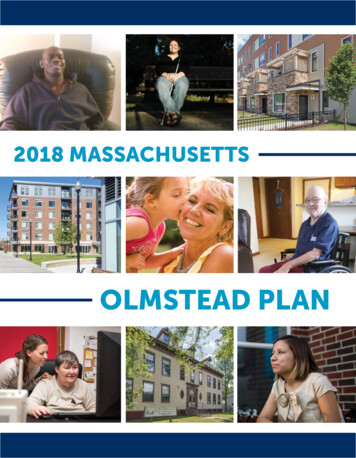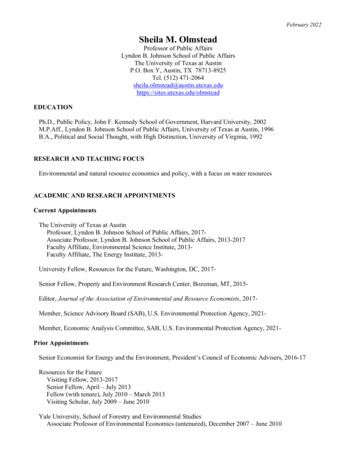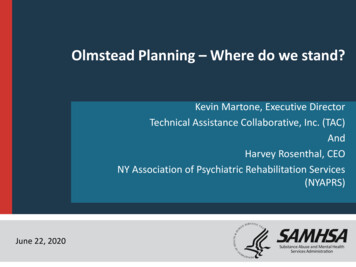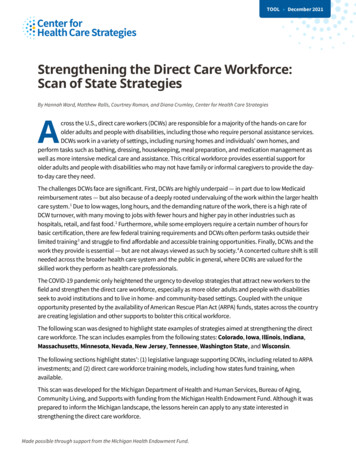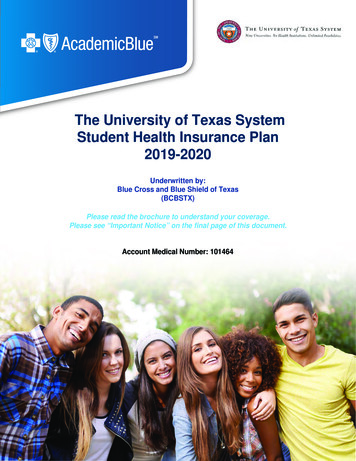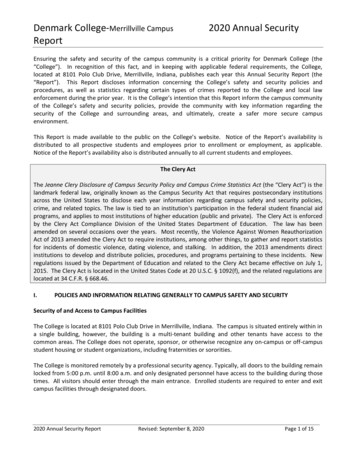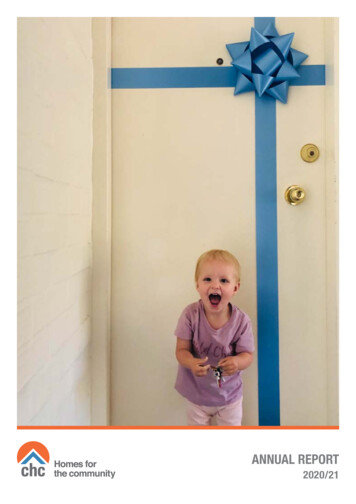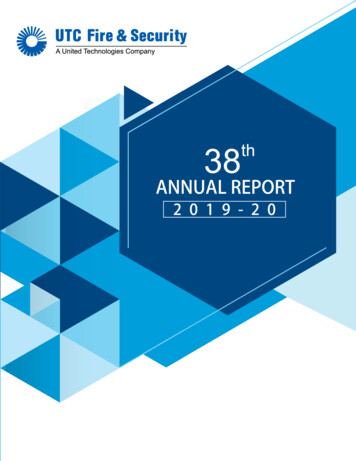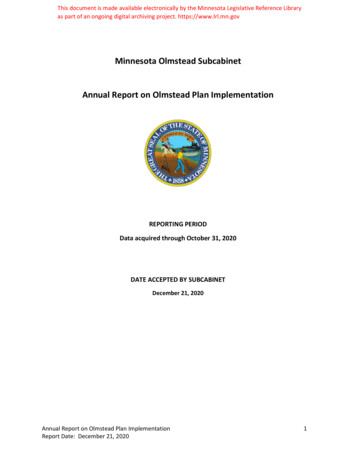
Transcription
This document is made available electronically by the Minnesota Legislative Reference Libraryas part of an ongoing digital archiving project. https://www.lrl.mn.govMinnesota Olmstead SubcabinetAnnual Report on Olmstead Plan ImplementationREPORTING PERIODData acquired through October 31, 2020DATE ACCEPTED BY SUBCABINETDecember 21, 2020Annual Report on Olmstead Plan ImplementationReport Date: December 21, 20201
ContentsI.PURPOSE OF REPORT . 4EXECUTIVE SUMMARY . 4II.MOVEMENT FROM SEGREGATED TO INTEGRATED SETTINGS . 7QUARTERLY SUMMARY OF MOVEMENT FROM SEGREGATED TO INTEGRATED . 7TRANSITION SERVICES GOAL ONE . 8TRANSITION SERVICES GOAL TWO . 14TRANSITION SERVICES GOAL THREE. 17TRANSITION SERVICES GOAL FOUR . 21III. TIMELINESS OF WAIVER FUNDING . 23TIMELINESS OF WAIVER FUNDING GOAL ONE. 23IV. QUALITY OF LIFE MEASUREMENT RESULTS . 27V.INCREASING SYSTEM CAPACITY AND OPTIONS FOR INTEGRATION . 30PERSON-CENTERED PLANNING GOAL ONE . 30PERSON-CENTERED PLANNING GOAL TWO . 32HOUSING AND SERVICES GOAL ONE . 36EMPLOYMENT GOAL ONE . 38EMPLOYMENT GOAL TWO . 42EMPLOYMENT GOAL THREE . 45EMPLOYMENT GOAL FOUR . 46LIFELONG LEARNING AND EDUCATION GOAL ONE . 48LIFELONG LEARNING AND EDUCATION GOAL TWO . 49LIFELONG LEARNING AND EDUCATION GOAL THREE . 51TRANSPORTATION GOAL ONE . 54TRANSPORTATION GOAL TWO . 57TRANSPORTATION GOAL THREE. 58TRANSPORTATION GOAL FOUR . 59TRANSPORTATION GOAL FIVE . 62HEALTHCARE AND HEALTHY LIVING GOAL ONE . 63HEALTHCARE AND HEALTHY LIVING GOAL TWO . 65POSITIVE SUPPORTS GOAL ONE . 67POSITIVE SUPPORTS GOAL TWO . 69POSITIVE SUPPORTS GOAL THREE . 70Annual Report on Olmstead Plan ImplementationReport Date: December 21, 20202
POSITIVE SUPPORTS GOAL FOUR . 72POSITIVE SUPPORTS GOAL FIVE . 74CRISIS SERVICES GOAL ONE . 77CRISIS SERVICES GOAL TWO . 79CRISIS SERVICES GOAL FOUR . 81CRISIS SERVICES GOAL FIVE . 84COMMUNITY ENGAGEMENT GOAL ONE . 85COMMUNITY ENGAGEMENT GOAL TWO . 86COMMUNITY ENGAGEMENT GOAL THREE . 87PREVENTING ABUSE AND NEGLECT GOAL TWO . 87PREVENTING ABUSE AND NEGLECT GOAL THREE . 88PREVENTING ABUSE AND NEGLECT GOAL FOUR . 90VI. COMPLIANCE REPORT ON WORKPLANS . 92VII. ANALYSIS OF TRENDS AND RISK AREAS . 93ENDNOTES . 94ADDENDUM . 95Annual Report on Olmstead Plan ImplementationReport Date: December 21, 20203
I.PURPOSE OF REPORTThis Annual Report provides the status of work being done by State agencies to implement theOlmstead Plan. The Annual Report summarizes measurable goal results and analysis of data as reportedin the previous four quarterly reports (February, May, August and November 2020). 1For the purpose of reporting, the measurable goals are grouped in four categories:1. Movement of people with disabilities from segregated to integrated settings2. Movement of individuals from waiting lists3. Quality of life measurement results4. Increasing system capacity and options for integrationThis Annual Report dated December 21, 2020 includes data acquired through October 31, 2020.Progress on each measurable goal is reported when data is reliable and valid in order to ensure theoverall report is complete, accurate, timely and verifiable. More details on the progress of the goals canbe found in the quarterly reports.This Annual Report includes Olmstead Implementation Office (OIO) compliance summary reports onstatus of workplans, and an analysis of trends and risk areas.EXECUTIVE SUMMARYThis Annual Report covers the forty-seven measurable goals i in the Olmstead Plan. As shown in thechart below, eighteen of those goals were either met or are on track to be met. Twenty-one goals werecategorized as not on track, or not met. For those twenty-one goals, the report documents how theagencies will work to improve performance on each goal. Eight goals were in process.Status of Goals* – 2020 Annual ReportMet annual goalOn track to meet annual goalNot on track to meet annual goalDid not meet annual goalIn processGoals ReportedNumber of Goals153021847*The status for each goal is based on the most recent annual goal reported. Each goal iscounted only once in the table.Listed below are areas critical to the Plan where measurable progress is being made.Progress on movement of people with disabilities from segregated to integrated settings In the first three quarters of the 2020 goal, 77 individuals left Intermediate Care Facilities forIndividuals with Developmental Disabilities (ICF/DD) programs to more integrated settings. Thisexceeds the 2020 annual goal of 72. (Transition Services Goal One A) In the first three quarters of the 2020 goal, 693 individuals with disabilities under age 65 in a nursingfacility longer than 90 days moved to more integrated settings. This is 92% of the 2020 annual goalof 750. (Transition Services Goal One B)1Quarterly Reports and other related documents are available on the Olmstead Plan website atMn.gov/Olmstead.Annual Report on Olmstead Plan ImplementationReport Date: December 21, 20204
In the first three quarters of the 2020 goal, 913 individuals moved from other segregated settings tomore integrated settings. This exceeds the 2020 annual goal of 500. (Transition Services Goal One C)Timeliness of Waiver Funding Goal One There are fewer individuals waiting for access to a DD waiver. In the last quarter reported. Over thelast four quarters, 59% of individuals were approved for funding within 45 days. Another 31% hadfunding approved after 45 days.Increasing system capacity and options for integration The utilization of Transition Protocols continues to show improvement. Over the last four quarters,the number of cases adhering to protocols averaged 78.3%, which is an increase from 64.8% fromthe previous year. (Transition Services Goal Four) The utilization of the Person Centered Protocols continues to show improvement. Over the lastfour quarters, of the eight person centered elements measured in the protocols, performance onall elements improved over the 2017 baseline. Six of the eight elements show progress over theprevious year, and five of the eight are at or above 97%. (Person-Centered Planning Goal One) The number of people with disabilities who live in the most integrated housing of their choiceincreased by 1,132 individuals over the last year. (Housing and Services Goal One) An additional 3,405 individuals receiving services from Vocational Rehabilitation Services and StateServices for the Blind, certain Medicaid funded programs, and students are in competitiveintegrated employment during the last year. (Employment Goal One, Two and Three) The number of peer support specialists who are employed remained unchanged at 76. This was anincrease of 60 over baseline. (Employment Goal Four) There was an increase in the number and percent of students with disabilities in the mostintegrated setting. (Education Goal One) There was an increase in the number of school districts that completed training in activeconsideration of assistive technology. (Education Goal Three A) Accessibility improvements were made to 1,188 curb ramps, 43 accessible pedestrian signals, and33.24 miles of sidewalks in the last year. (Transportation Goal One) The number of transit service hours in Greater Minnesota increased by 242,652 over baselineduring the last year. (Transportation Foal Two) The number of individuals experiencing a restrictive procedure was reduced by 81 from theprevious year and a reduction of 515 from baseline. (Positive Supports Goal One) The number of reports of restrictive procedures was reduced by 97 from the previous year and areduction of 5,476 from baseline. (Positive Supports Goal Two) The percent of people receiving appropriate community services within 30 days of discharge fromthe hospital (due to a crisis) was 94.6%, which met the annual goal of 92%. (Crisis Services Four B) The percentage of people receiving crisis services within ten days of referral was 96.5%, which metthe annual goal of 90%. (Crisis Services Goal Five) The number of individuals participating in public input opportunities increased by 11.5% over theprevious year. The number of comments received increased by 173% over the previous year.(Community Engagement Goal Two) The number of vulnerable adults who experienced more than one episode of the same type ofabuse or neglect within six months was reduced by 25.4% from baseline. (Preventing Abuse andNeglect Goal Three)Annual Report on Olmstead Plan ImplementationReport Date: December 21, 20205
The following measurable goals have been targeted for improvement: Transition Services Goal Three to increase the number of individuals leaving the MSH to a moreintegrated setting. Education Goal Two to increase the percent of students with disabilities enrolling in integratedpostsecondary education settings. Education Goal Three B to increase the percent of students with disabilities in districts trained inactive consideration of assistive technology. Health Care and Healthy Living Goal One to decrease the rate of adults with disabilities who had anunplanned readmission after an acute inpatient hospital stay. Health Care and Healthy Living Goal Two to decrease the rate of children and adults who used anemergency department for non-traumatic dental services. Positive Supports Three to reduce the number of reports of emergency use of mechanical restraints(other than auxiliary devices) with approved individuals. Positive Supports Four and Five to reduce the number of students experiencing emergency use ofrestrictive procedures and the number of incidents of emergency use of restrictive procedures. Crisis Services One and Two to increase the percent of children and adults who remain in thecommunity after a crisis episode. Crisis Services Four A to increase the percent of people who are housed five months after dischargefrom the hospital (due to a crisis). Community Engagement Goal One to increase the number of individuals with disabilitiesparticipating in Governor’s appointed Boards and Commissions, and the Olmstead SubcabinetCommunity Engagement Workgroup. Preventing Abuse and Neglect Goal Four to decrease the number of students with disabilitiesidentified as victims in determinations of maltreatment.The following measurable goals are in process and have no current annual goals. New annual goalsare being proposed and included in the Addendum for the following goals: Transition Services Goal Two to decrease the percent of people at AMRTC who no longer meethospital level of care and are currently awaiting discharge to the most integrated setting. Person-Centered Planning Goal Two (A/B/C) to increase the percent of individuals reporting theyhave input in major life decisions, everyday decisions, and their supports and services as measuredby the National Core Indicators Survey.The Olmstead Plan is not intended to be a static document that establishes a one-time set of goals forState agencies. Rather, it is intended to serve as a vital, dynamic roadmap that will help realize theSubcabinet’s vision of people with disabilities living, learning, working, and enjoying life in the mostintegrated settings. The dynamic nature of the Plan means that the Olmstead Subcabinet regularlyexamines the goals, strategies, and workplan activities to ensure that they are the most effective meansto achieve meaningful change.The ultimate success of the Olmstead Plan will be measured by an increase in the number of peoplewith disabilities who, based upon their choices, live close to their friends and family, and asindependently as possible, work in competitive, integrated employment, are educated in integratedschool settings, and fully participate in community life. While there is much work to be done to achievethe goals of the Olmstead Plan, significant strides have been made in the last year. It is anticipated thatfuture reports will include additional indicators of important progress towards these larger goals.Annual Report on Olmstead Plan ImplementationReport Date: December 21, 20206
II.MOVEMENT FROM SEGREGATED TO INTEGRATED SETTINGSThis section reports on the progress of five separate Olmstead Plan goals that assess movement ofindividuals from segregated to integrated settings.QUARTERLY SUMMARY OF MOVEMENT FROM SEGREGATED TO INTEGRATEDThe table below indicates the cumulative net number of individuals who moved from varioussegregated settings to integrated settings for each of the five goals included in this report. Thereporting period for each goal is based on when the data collected can be considered reliable andvalid.Net number of individuals who moved from segregated to integrated settings during reporting periodSetting Intermediate Care Facilities for Individuals with DevelopmentalDisabilities (ICFs/DD) Nursing Facilities(individuals under age 65 in facility 90 days) Other segregated settings Anoka Metro Regional Treatment Center (AMRTC) Minnesota Security Hospital (MSH)TotalReporting periodJuly 2018 –June 2019July 2018 –June 2019July 2018 –June 2019July 2019 –June 2020January –December 2019--Numbermoved2208801,138104912,433More detailed information for each specific goal is included below. The information includes the overallgoal, the annual goal, baseline, results for the reporting period, analysis of the data and a comment onperformance and the universe number when available. The universe number is the total number ofindividuals potentially impacted by the goal. The number provides context as it relates to the measure.Annual Report on Olmstead Plan ImplementationReport Date: December 21, 20207
TRANSITION SERVICES GOAL ONE: By June 30, 2020, the number of people who have moved fromsegregated settings to more integrated settings ii will be 7,138.Annual Goals for the number of people moving from ICFs/DD, nursing facilities and other segregatedhousing to more integrated settings are set forth in the following table:2014BaselineJune 30,2015June 30,2016June 30,2017June 30,2018June 30,2019June 504005005005008741,0741,2241,3221,3221,322A) Intermediate Care Facilities forIndividuals with DevelopmentalDisabilities (ICFs/DD)B) Nursing Facilities (NF) underage 65 in NF 90 daysC) Segregated housing other thanlisted aboveTotalA) INTERMEDIATE CARE FACILITIES FOR PERSONS WITH DEVELOPMENTAL DISABILITIES (ICFs/DD)Annual Goals 2019 goal: For the year ending June 30, 2019 the number of people who have moved from ICFs/DDto a more integrated setting will be 72 2020 goal: For the year ending June 30, 2020 the number of people who have moved from ICFs/DDto a more integrated setting will be 72Baseline: January - December 2014 72RESULTS: The 2019 goal to move 72 people from ICFs/DD to a more integrated setting was met. [Reported inFebruary 2020] The 2020 goal of 72 is on track. [Last reported in November 2020]Time periodBaseline (January – December 2014)2015 Annual (July 2014 – June 2015)2016 Annual (July 2015 – June 2016)2017 Annual (July 2016 – June 2017)2018 Annual (July 2017 – June 2018)2019 Annual (July 2018 – June 2019)Total numberof individualsleaving-138180263216298Transfers iii(-)-1827251520-6272565158Net moved 421321491359772020 Quarter 1 (July – September 2019)2020 Quarter 2 (October – December 2019)2020 Quarter 3 (January – March 2020)Totals (Q1 Q2 Q3)Annual Report on Olmstead Plan ImplementationReport Date: December 21, 2020Deaths(-)8
ANALYSIS OF DATA:From July 2018 – June 2019, the number of people moving from an ICF/DD to a more integrated settingwas 220. The 2019 goal of 72 was met.For the 2020 goal, during the first three quarters, 77 people moved from an ICF/DD to a more integratedsetting which exceeds the annual goal of 72. The 2020 goal is on track to be met.COMMENT ON PERFORMANCE:DHS provides reports to counties about persons in ICFs/DD who are not opposed to moving withcommunity services, as based on their last assessment. As part of the current reassessment process,individuals are being asked whether they would like to explore alternative community services in thenext 12 months. Some individuals who expressed an interest in moving changed their minds, or theywould like a longer planning period before they move.For those leaving an institutional setting, such as an ICF/DD, the Olmstead Plan reasonable pace goal isto ensure access to waiver services funding within 45 days of requesting community services. DHSmonitors and provides technical assistance to counties in providing timely access to the funding andplanning necessary to facilitate a transition to community services.DHS continues to work with private providers and Minnesota State Operated Community Services(MSOCS) that have expressed interest in voluntary closure of ICFs/DD. Providers are working to developservice delivery models that better reflect a community–integrated approach requested by peopleseeking services.UNIVERSE NUMBER:In June 2017, there were 1,383 individuals receiving services in an ICF/DD.TIMELINESS OF DATA:In order for this data to be reliable and valid, it is reported six months after the end of the reportingperiod.Annual Report on Olmstead Plan ImplementationReport Date: December 21, 20209
B) NURSING FACILITIESAnnual Goals 2019 goal: For the year ending June 30, 2019, the number of people who have moved from NursingFacilities (for persons with a disability under 65 in facility longer than 90 days) to a more integratedsetting will be 750. 2020 Goal: For the year ending June 30, 2020 the number of people who have moved from NursingFacilities (for persons with a disability under 65 in facility longer than 90 days) to a more integratedsetting will be 750Baseline: January - December 2014 707RESULTS: The 2019 goal to move 750 people (under age 65) from Nursing Facilities to a more integratedsetting was met. [Reported in February 2020] The 2020 goal of 750 is on track. [Last reported in November 2020]Time periodTotal number ofindividuals ,176-70917787106-224198196197190Net moved tointegratedsetting7077497298248308802020 Quarter 1 (July – September 2019)2020 Quarter 2 (October – December 2019)2020 Quarter 3 (January – March 2020)289314329292720495460211233249Totals (Q1 Q2 Q3)93276163693Baseline (January – December 2014)2015 Annual (July 2014 – June 2015)2016 Annual (July 2015 – June 2016)2017 Annual (July 2016 – June 2017)2018 Annual (July 2017 – June 2018)2019 Annual (July 2018 – June 2019)ANALYSIS OF DATA:From July 2018 – June 2019, the number of people under 65 in a nursing facility for more than 90 dayswho moved to a more integrated setting was 880. The 2019 goal of 750 was met.For the 2020 goal, during the first three quarters, 693 people under the age of 65 moved to a moreintegrated settings. This is 92% of the annual goal of 750. If moves continue at approximately the samerate, the 2020 goal is on track to be met.COMMENT ON PERFORMANCE:DHS reviews data and notifies lead agencies of people who accepted or did not oppose a move to moreintegrated options. Lead agencies are expected to work with these individuals to begin to plan theirmoves. DHS continues to work with partners in other agencies to improve the supply of affordablehousing and knowledge of housing subsidies.In July 2016, Medicaid payment for Housing Access Services was expanded across waivers. Additionalproviders are now able to enroll to provide this service. Housing Access Services assists people withAnnual Report on Olmstead Plan ImplementationReport Date: December 21, 202010
finding housing and setting up their new place, including a certain amount of basic furniture, householdgoods and/or supplies and payment of certain deposits.UNIVERSE NUMBER:In June 2017, there were 1,502 individuals with disabilities under age 65 who received services in anursing facility for longer than 90 days.TIMELINESS OF DATA:In order for this data to be reliable and valid, it is reported six months after the end of the reportingperiod.C) SEGREGATED HOUSINGAnnual Goals 2019 Goal: For the year ending June 30, 2019, the number of people who have moved from othersegregated housing to a more integrated setting will be 500. 2020 Goal: For the year ending June 30, 2020, the number of people who have moved from othersegregated housing to a more integrated setting will be 500.BASELINE: During July 2013 – June 2014, of the 5,694 individuals moving, 1,121 moved to a moreintegrated setting.RESULTS: The 2019 goal to move 500 people from segregated housing to a more integrated setting was met.[Reported in February 2020] The 2020 goal of 500 is on track. [Last reported in November 2020]Time periodTotalmoves[Receiving Medical Assistance (MA)]Moved to more Moved toNot tingservices1,121 (19.7%)--1,137 (19.9%) 502 (8.8%) 3,805 (66.7%)1,051 (18.8%) 437 (7.8%) 3,692 (65.9%)1,054 (19.2%) 492 (8.9%) 3,466 (63.0%)1,188 (19.9%) 516 (8.7%)3,737(62.6%)1,138 (20.0%) 484 (8.5%) 3,479 (61.3%)No longeron MABaseline (July 2013 – June 2014)2015 Annual (July 14 – June 15)2016 Annual (July 15 – June 16)2017 Annual (July 16 – June 17)2018 Annual (July 17 – June 18)2019 Annual (July 18 – June 19)5,6945,7035,6035,5045,9675,679-259 (4.6%)423 (7.5%)492 (8.9%)526 (8.8%)578 (10.2%)2020 Quarter 1 (July – Sept 2019)2020 Quarter 2 (Oct – Dec 2019)2020 Quarter 3 (Jan – Mar 2020)1,5201,4651,520284 (18.7%)320 (21.8%)309 (20.3%)122 (8%)120 (8%)152 (10%)954 (62.6%)892 (61.0%)952 (62.7%)160 (10.5%)133 (9.0%)107 (7.0%)Totals (Q1 Q2 Q3)4,505913 (20.3%)394 (8.7%)2,798 (62.1%)400 (8.9%)ANALYSIS OF DATA:From July 2018 – June 2019, of the 5,679 individuals moving from segregated housing, 1,138 individuals(20.0%) moved to a more integrated setting. The 2019 goal of 500 was met.Annual Report on Olmstead Plan ImplementationReport Date: December 21, 202011
For the 2020 goal, during the first three quarters, 913 individuals moved to a more integrated settingwhich exceeds the annual goal of 500. The 2020 goal is on track to be met.COMMENT ON PERFORMANCE:During the first three quarters reported for the 2019 goal, there were significantly more individuals whomoved to more integrated settings (20.3%) than who moved to congregate settings (8.7%). This analysisalso illustrates the number of individuals who are no longer on MA and who are not receiving residentialservices as defined below.The data indicates that a large percentage (62.1%) of individuals who moved from segregated housingare not receiving publicly funded residential services. Based on trends identified in data developmentfor Crisis Services Goal Four, it is assumed the majority of those people are housed in their own or theirfamily’s home and are not in a congregate setting.COMMENT ON TABLE HEADINGS:The language below provides context and data definitions for the headings in the table above.Total Moves: Total number of people in one of the following settings for 90 days or more and had achange in status during the reporting period: Adult corporate foster care Supervised living facilities Supported living services (DD waiver foster care or in own home) Board and Care or Board and Lodge facilitiesMoves are counted when someone moves to one of the following: More Integrated Setting (DHS paid) Congregate Setting (DHS paid) No longer on Medical Assistance (MA) Not receiving residential services (DHS paid) Deaths are not counted in the total moved columnMoved to More Integrated Setting: Total number of people that moved from a congregate setting toone of the following DHS paid settings for at least 90 days: Adult family foster care Adult corporate foster care (when moving from Board and Care or Board and Lodge facilities) Child foster care waiver Housing with services Supportive housing Waiver non-residential Supervised living facilities (when moving from Board and Care or Board and Lodge facilities)Moved to Congregate Setting: Total number of people that moved from one DHS paid congregatesetting to another for at least 90 days. DHS paid congregate settings include: Board and Care or Board and Lodge facilities Intermediate Care Facilities (ICFs/DD) Nursing facilities (NF)Annual Report on Olmstead Plan ImplementationReport Date: December 21, 202012
No Longer on MA: People who currently do not have an open file on public programs in MAXIS or MMISdata systems.Not Receiving Residential Services: People in this group are on Medical Assistance to pay for basic care,drugs, mental health treatment, etc. This group does not use other DHS paid services such as waivers,home care or institutional services. The data used to identify moves comes from two different datasystems: Medicaid Management Information System (MMIS) and MAXIS. People may have addresses orliving situations identified in either or both systems. DHS is unable to use the address data to determineif the person moved to a more integrated setting or a congregate setting; or if a person’s new settingwas obtained less than 90 days after leaving a congregate setting. Based on trends identified in datadevelopment for Crisis Services Goal Four, it is assumed the majority of these people are housed in theirown or their family’s home and are not in a congregate setting.TIMELINESS OF DATA:In order for this data to be reliable and valid, it is reported six months after the end of the reportingperiod.Annual Report on Olmstead Plan ImplementationReport Date: December 21, 202013
TRANSITION SERVICES GOAL TWO: By June 30, 2020, the percent of people under m
Annual Report on Olmstead Plan Implementation 1 Report Date: December 21, 2020 . Minnesota Olmstead Subcabinet . Annual Report on Olmstead Plan Implementation . REPORTING PERIOD . Data acquired through October 31, 2020 . DATE ACCEPTED BY SUBCABINET . December 21, 2020
